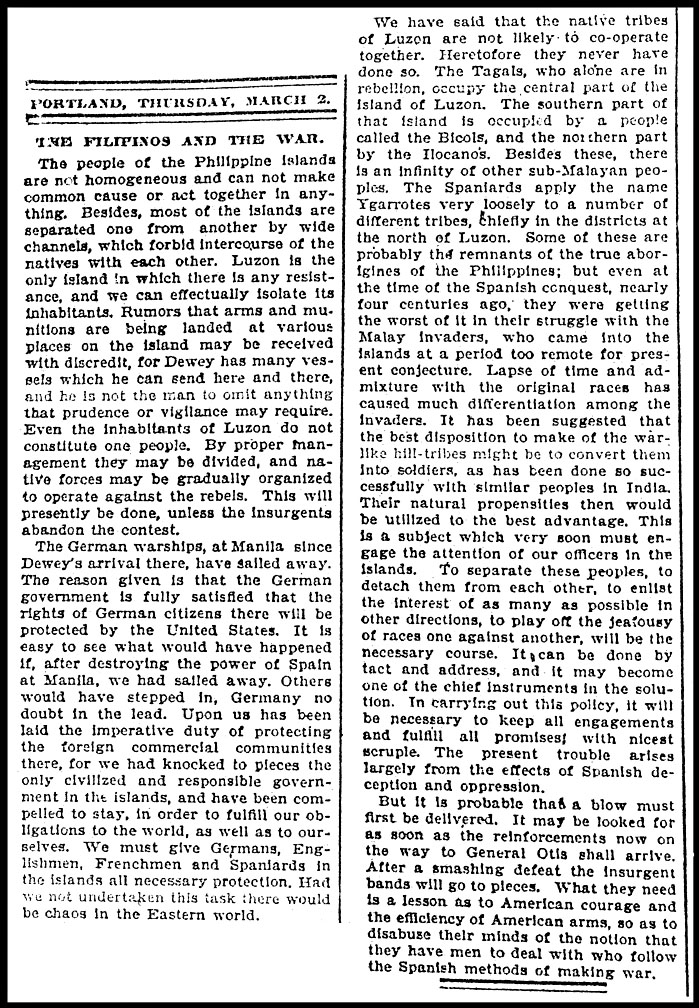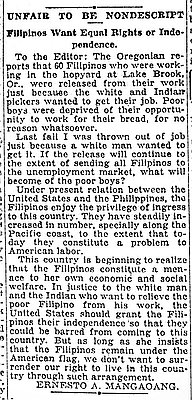- Catalog No. —
- Oregonian, March 2, 1899
- Date —
- March 2, 1899
- Era —
- 1881-1920 (Industrialization and Progressive Reform)
- Themes —
- Government, Law, and Politics, Race, Ethnicity, and Nationality, Trade, Business, Industry, and the Economy
- Credits —
- Oregon Historical Society
- Regions —
- None
- Author —
- The Oregonian
News Editorial, The Filipinos and the War
This editorial appeared in the Oregonian on March 2, 1899. Titled “The Filipinos and the War,” it argues that one of the best ways to bring the Philippines under American control would be to exacerbate divisions between the archipelago’s diverse ethnic groups, “to play off the jealousy of races one against another.” It concludes by calling for a decisive strike against Filipino independence fighters, to “give them a lesson as to American courage and the efficiency of American arms.”
The Philippines were an unexpected prize of the Spanish-American War, which began as a conflict over Cuba in the spring of 1898. The Philippine archipelago had been a Spanish colony since the sixteenth century and in 1898 the islands were home to the Spanish Pacific fleet. Commodore George Dewey, commander of the U.S. Navy’s Asiatic Squadron, sailed into Manila Bay that May and easily destroyed the obsolete Spanish vessels. The next month American ground forces moved into Manila, preventing Filipino independence fighters from occupying the archipelago’s largest city.
American and Filipino forces engaged in an uneasy stand-off for more than seven months while the American public debated over what to do with the islands. A vocal anti-imperialist movement arose in the United States, but by the end of 1898 many editors, politicians, clergy, and other public opinion leaders were suggesting that the U.S. should keep the entire archipelago as a colony. Not only were the islands a stepping stone to the vast China market, expansionists argued, they also had valuable agricultural and mineral resources that could be exploited.
The Oregonian was a vocal advocate of American expansionism. To help bolster its case, the newspaper often portrayed the Philippines as a wilderness populated by ignorant savages unfit for self-governance. The Oregonian argued on a number of occasions that racially inferior “Asiatics” only understood brute force, and promised that the Philippines would be a “bone orchard” if the Filipinos continued to resist American authority.
By the time the editorial reproduced here was published, however, the Philippines question was largely moot. American forces had already attacked the Philippine republican army in February, initiating a bloody guerrilla war that resulted in the deaths of hundreds of thousands of Filipino civilians and soldiers and more than 4,000 Americans before the islands were finally brought under U.S. control.
Further Reading:
McEnroe, Sean. “Painting the Philippines with an American Brush: Visions of Race and National Mission among the Oregon Volunteers in the Philippine Wars of 1898 and 1899.” Oregon Historical Quarterly 104, 2003: 24-41.
Miller, Stuart Creighton. “Benevolent Assimilation”: The American Conquest of the Philippines, 1899-1903. New Haven, Conn., 1982.
Reynaldo C. Ileto. “The Philippine-American War: Friendship and Forgetting.” In Vestiges of War: The Philippine-American War and the Aftermath of an Imperial Dream, 1899-1999. Angel Velasco Shaw and Luis H. Francia, eds. New York, N.Y., 2002.
Written by Cain Allen, © Oregon Historical Society, 2004.

